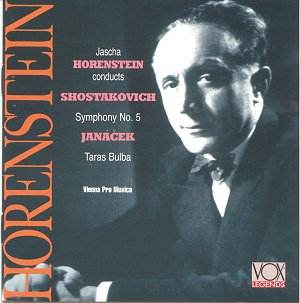SHOSTAKOVICH
Symphony No.5 in D minor
JANACEK:
Taras Bulba - Rhapsody For Orchestra
 Vienna Pro Musica Conducted
by Jascha Horenstein
Vienna Pro Musica Conducted
by Jascha Horenstein
 (Recordings from 1952 and
1955) Vox Legends Vox
7803
(Recordings from 1952 and
1955) Vox Legends Vox
7803
Amazon
US mid-price

In his series of recordings for Vox in the 1950s Horenstein blended the familiar
with the unfamiliar. In addition to Beethoven, Brahms, Mozart and Dvorak
he made pioneering recordings of Mahler, Bruckner, Schoenberg and Stravinsky.
The two works on this reissue fall into that category and in the case of
the Shostakovich Fifth Symphony we have what must have been one of the first,
if not the first, LP recording of the work. In 1952 the symphony was
only fifteen years old, remember, so this could have been the first time
admirers of this composer were able to hear this work at home without
interruption when they wanted. And I do believe there is a special quality
to early or first recordings. Unencumbered by routine and filled with zeal
to do the right thing by a composer, they are often much fresher sounding
than later efforts, analogous to newly painted canvases even though unfamiliarity
might bring some insecurity in playing.
In the first movement the overriding impression given by Horenstein is a
refreshing need to press forward with the orchestra responding to a need
to explore the score, almost as if they are aware of setting down a reference
for others to follow. There is no attempt by Horenstein to weigh down the
music with too much despondency which helps at the movement's central crisis
where his unerring sense of the structure of the movement means he builds
with the hand of a master engineer allied to edginess. The aftermath of this,
though relatively consoling, doesn't give as much comfort as it can and in
that accentuates an uneasy mood. In the second movement Mahlerian influences
appear in Shostakovich's writing. He had attended Mahler performances by
Horenstein in Russia around the time of writing this work that makes this
recording a document of even greater interest. Interestingly, however, Horenstein
seems careful to stress the Shostakovich quality to this movement. Notice
how the well-balanced mono recording also catches just about everything from
the growls of the lower brass to the harp and the string slides. Following
this Horenstein reads the elegiac third movement "straight". What emerges
is intensely moving for being quite cold. I also had a strong feeling, stronger
than usual, that the central crisis of this third movement is a counterpart
to that of the first. The passage immediately afterwards is "argued" by
Horenstein, conveying a feeling that even he isn't yet quite sure how it
should go. Again the impression coming over is that this early in the work's
history interpreters are still feeling their way. By the end of the movement,
however, an intimacy enters and I couldn't help but be reminded that this
music emerged from a time when the Russian political climate was very harsh.
Here it is being played against a background where the Cold War was at its
most frozen in a city closer than most to the Iron Curtain. With Shostakovich
you cannot escape these impressions.
Horenstein's reading of the last movement is, by the nature of its recording
date, utterly without overtones of trying to read what Shostakovich might
have "really" been trying to say. The close therefore has a genuine nobility;
an enhancing of the spirit whose meaning can be read in any number of ways.
The early recording copes well with the demands the score makes on it with
a well-balanced, honest sound picture of an orchestra anxious to give their
best. The orchestra hiding behind the name "Vienna Pro Musica" on this disc
is, by the way, the Vienna Symphony Orchestra.
No less important or enjoyable is the recording of Janacek's Taras Bulba
from 1955. The recording quality isn't quite as good as that for the Shostakovich
in being closer and less atmospheric. Throughout the performance Horenstein
is adept at seeming to tell a developing story. In fact the whole piece emerges
with the fluency of a film soundtrack, changing from moment to moment. In
the latter animated passage of The Death of Andriy there is a wonderful
truculence to Horenstein's craggy sound palette that is then balanced by
brilliance to the lyricism against which it is pitted. The Prophecy and Death
builds to a grand climax with the final string peroration splendidly projected
and within the texture rather than outside it. This is as distinguished a
reading as that of the Shostakovich Symphony and is a very generous coupling
for a work that usually appears alone.
Reviewer
Tony Duggan
Shostakovich:
Performance:

Sound:

Janacek:
Performance:

Sound:

